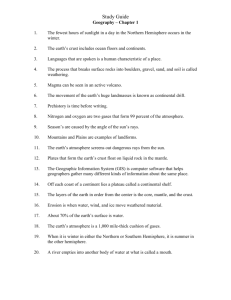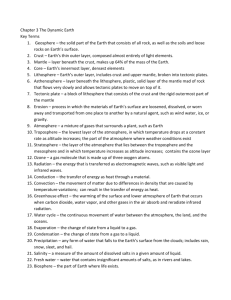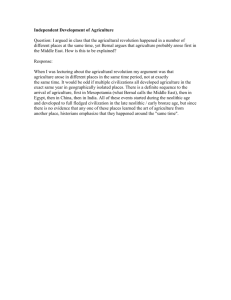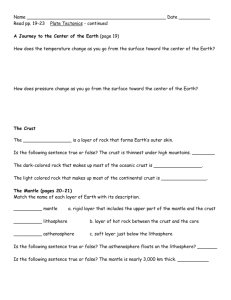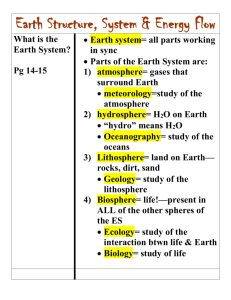Diapositiva 1 - Claseshistoria.com
advertisement
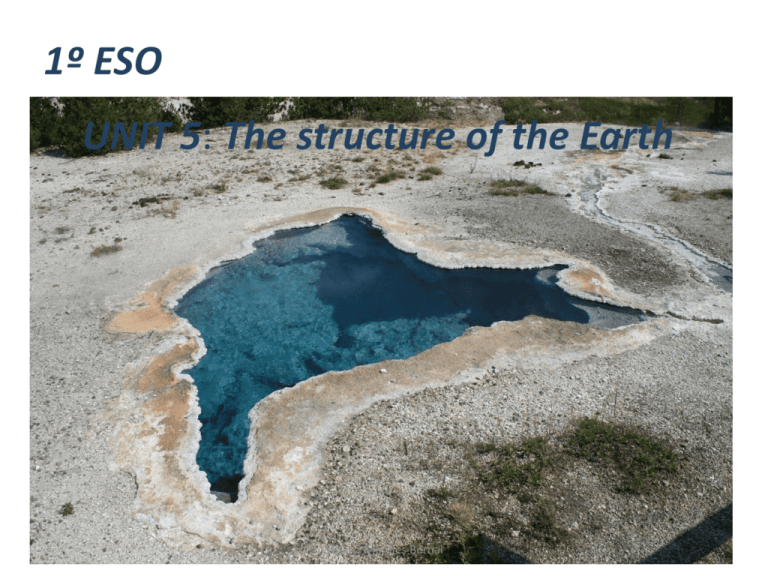
1º ESO UNIT 5: The structure of the Earth Susana Morales Bernal Objectives 1. To know the main layers of the Earth names. 2. To know the layers of the atmosphere and its main characteristics. 3. To know the variables that influence on the weather and how they are measured. 4. To know the distribution of water on Earth. 5. To know what the greenhouse effect is and the problem its increase creates. 6. To know the causes of atmospheric pollution, their characteristics and ways of alleviating them. 7. To know the existence of the atmospheric pressure and how to apply it to explain the everyday phenomena. 8. To know the most common atmospheric phenomena: rain, snow, hail, mist. 9. To know the Earth's water cycle. 10. To know the types of water we use, how the water reaches our homes and what is necessary to make it drinkable. 11. To know the causes of water pollution, their characteristics and ways of alleviating them. 12. To know the structure of the crust of the Earth and its composition. 13. To understand the concepts of minerals and rocks. 14. To know the geological processes that give rise to different types of rocks. 15. To know the Earth's rock cycle. 16. To know how to classify a material as artificial or natural. Susana Morales Bernal THE EARTH Until now it hasn't been possible to take a look inside the earth because the current technology doesn't allow it. Therefore, all kinds of research had to be done to find out, which material the earth consists of and what different layers there are. This research is called seismology. Seismology is the study of earthquakes and seismic waves that move through and around the earth (the study of the vibration of the Earth's interior caused by natural and unnatural sources). A seismologist is a scientist who studies earthquakes and seismic waves. A geologist is a scientist who studies the Earth and geology is the science that studies our planet. Susana Morales Bernal THE EARTH The Earth, the Sun, and the rest of the solar system, were formed 4.54 million years ago by accretion from a rotating disk of dust and gas. UPPER MANTLE CRUST MANTLE The earth consists of several layers. The three main layers are the core, the mantle and the crust. The core is the inner part of the earth, the crust is the outer part and between them, is the mantle. The earth is surrounded by the hydrosphere and the atmosphere. HYDROSPHERE CORE ATMOSPHERE Susana Morales Bernal THE EARTH Denser materials like iron (Fe) sank into the core of the Earth, while lighter silicates (silicon (Si) compounds), other oxygen (O) compounds and water rose near the surface. THICKNESS LAYER COMPOSITION CONTINENTAL CRUST 25-70 km OCEANIC CRUST 6-18 km MANTLE 2900 km Silicon rocks OUTER CORE 2200 km Iron and nickel molten INNER CORE 1250 km Iron and nickel solid Susana Morales Bernal Silicon rocks THE CRUST The crust lays above the mantle and is the earth's hard outer shell, the surface we are living on. In relation with the other layers the crust is much thinner. It floats upon the softer, denser mantle. The crust is made up of solid material but this material is not everywhere the same. There is an Oceanic crust and a Continental crust. The Oceanic Crust is the part that surfaces in the ocean basins with the exception of the continental shelf. It is about 6-18 km thick and consists of heavy rocks, like basalt and gabbro. The Continental crust is thicker than the Oceanic crust, about 25-70 km thick which form the continents and the areas of shallow seabed close to their shores, known as continental shelves. It is mainly made up of light material, like granite and limestone. Susana Morales Bernal THE COMPOSITION OF THE CRUST Most of the substances which form the crust are compounds. The more abundant compounds in the Earth's crust are: Composition of Earth's crust in weight per cent SiO2 (Silicon dioxide) Al2O3 (Aluminium trioxide) FeO (Iron monoxide) 55,2 % 15,3 % 8,6 % The following eight elements form the 98.5 % of the Earth's crust: O Si Al Fe Ca Na K Mg (Oxygen) (Silicon) (Aluminium) (Iron) (Calcium) (Sodium) (Potassium) (Magnesium) Susana Morales Bernal The oxygen and silicon form three-quarters of the crust. 46,6 % 27,7 % 8,1 % 5% 3,6 % 2,8 % 2,6 % 2,1 % THE MANTLE The layer above the core is the mantle. It begins about 10 km below the oceanic crust and about 30 km below the continental crust. The mantle is divided into two layers, the inner mantle and the outer mantle. It is about 2900 km thick and makes up nearly 80 per cent of the Earth's total volume. The lithosphere is the crust and the upper part of the mantle. The lithosphere is about 8 to 50 km deep. Susana Morales Bernal THE COMPOSITION OF THE MANTLE The most abundant compounds in the Earth's mantle are: SiO2 (Silicon dioxide) MgO FeO (Iron monoxide) Al2O3 (Aluminium trioxide) CaO Na2O K2O 46 % 37,8 % 7,5 % 4,2 % 3,2 % 0,4 % 0,04 % The most abundant elements in the Earth's mantle are: O Mg Si Fe Ca Al Na K (Oxygen) (Magnesium) (Silicon) (Iron) (Calcium) (Aluminium) (Sodium) Susana Morales Bernal (Potassium) 44,8 % 22,8 % 21,5 % 5,8 % 2,3 % 2,2 % 0,3 % 0,03 % THE CORE It´s the inner part of the Earth. It is about 2900 km below the earth's surface. The core is a dense ball of iron and nickel. It is divided into two layers, the inner core and the outer core. The inner core, the centre of Earth, is solid and about 1250 km thick. The outer core is so hot that metal is always molten, but the inner core is under such an extreme pressure that remains solid, even though temperatures there reach 3700ºC. The outer core is about 2200 km thick. Because the Earth rotates, the outer core spins around the inner core and that causes the earth's magnetism. Susana Morales Bernal MINERALS AND ROCKS A mineral, by definition, is any naturally occurring, inorganic and solid substance, often additionally characterized by an exact crystal structure. Elements that occur naturally are also considered minerals. The best way to define a rock is to say that it is an indefinite mixture of naturally occurring substances, mainly minerals. A rock is an aggregate of minerals formed during geological processes. Sodium chloride Many rocks are not solid such as magma and clay. The mantle and the crust are madeSusana of rocks. Morales Bernal Limestone TYPES OF ROCKS The three main types, or classes, of rocks are: sedimentary, metamorphic, and igneous and the differences among them have to do with how they are formed. SEDIMENTARY METAMORPHIC IGNEOUS Sedimentary rocks are those which have been formed from particles of sand, shells, pebbles, and other fragments of materials. All these particles are called sediments. Gradually, the sediments accumulated in layers over a long period of time hardens into rock. Generally, a sedimentary rock is fairly soft and may break apart or crumble easily. You can often see sand, pebbles, or stones in rocks, and it is usually the only type that contains fossils. Metamorphic rocks are those which have been changed inside the Earth's crust by heat, pressure and chemical activity. Rocks do not melt, but they do change and crystals form. Both igneous and sedimentary rocks can be metamorphosed. The rocks that result from these processes can be identified by their striped or banded appearance. Besides, they may have shiny crystals, formed by minerals that grow slowly over time, on their surface. Igneous rocks are those which have been formed when magma (molten rock within the earth) cools and hardens. Sometimes, the magma cools inside the earth and crystals form, and other times it erupts on the surface from volcanoes (in this case, it is called lava). When lava cools very quickly, no crystals form, the rock is shiny and it looks as if it was glass. Sometimes, gas bubbles are trapped in the rock during the cooling process, leaving tiny holes in the rock. Conglomerate, limestone, sandstone, slate, clay Gneiss, marble Basalt , obsidian, granite, pumice Susana Morales Bernal SOME ROCKS conglomerate marble limestone Susana Morales Bernal basalt gneiss obsidian THE ROCK CYCLE The Rock Cycle is a group of changes. THE ROCK CYCLE Igneous rock can change into sedimentary rock or into metamorphic rock. Sedimentary rock can change into metamorphic rock or into igneous rock. Metamorphic rock can change into igneous or sedimentary rock. Susana Morales Bernal THE ATMOSPHERE The Earth is surrounded by all kind of gases. This layer is called atmosphere. Without this atmosphere life on Earth is not possible. The atmosphere gives us air, water, warmth and protects us against harmful sun rays and against meteorites. This layer around the Earth is a colourless, odourless, tasteless 'sea' of gases, water and fine dust. It consists of 78% nitrogen, 21% oxygen, 0,93% argon, 0,03% carbon dioxide and 0,04% of other gases. The atmosphere is made up of different layers with different Susana Morales Bernal qualities. THE LAYERS OF THE ATMOSPHERE There are several layers in the atmosphere. The atmosphere is about 800 km thick. The troposphere is where the best known meteorological phenomena occur: clouds, rain, snow, winds, etc. The troposphere begins at the Earth's surface and extends up 6-20 km high. This is where we live. Above this layer is the stratosphere, between 12 and 50 km high, within the stratosphere is the ozone layer, that absorbs the Sun's harmful ultraviolet rays. Above the stratosphere is the mesosphere, is about 30 km thick. Many rock fragments from space burn up in the mesosphere. There is virtually no air. The thermosphere is so big that is divided into two additional parts: the ionosphere and the exosphere. The lower thermosphere is called the ionosphere; it extends from 80 to 550 kilometers above the Earth's surface and is where temperatures rise continually beyond 1000°C. The few molecules present receive extraordinary amounts of energy from the Sun, causing that this layer warms to such high temperatures and that ions occur (atoms with electrical load). These ions are important because they reflect radio waves. It is where the auroras borealis take place. The outer layer of the thermosphere is called the exosphere. The exosphere extends from 550 kilometers to thousands of kilometers into space. It is here that satellites orbit the Earth. These satellites control functions, from telephone messages Morales to TV programs, and are also important in Susana keeping anBernal eye on the Earth's weather. ATMOSPHERIC PRESSURE OF EARTH Air, is a mixture of gases which also weighs (have mass). Since air weighs, it is logical to think that the atmosphere weighs, too. The weight of the atmosphere is responsible for what is known as atmospheric pressure The atmospheric air pushes the bodies which are in contact with him in all directions: upwards, downwards, sidewards, etc. So, we say that the atmospheric air puts pressure on the bodies and that pressure is called atmospheric pressure. That pressure is not the same every day or in all places and decreases with height. Since the atmospheric air pushes in all directions is difficult to notice its existence. We will be able to notice it if we avoid that the air pushes an object in a particular direction. Air can not push the water down through the glass, but pushes it up, for this reason, the water does not fall. Susana Morales Bernal THE GREENHOUSE EFFECT The greenhouse effect is the rise in temperature that the Earth experiences because of the existence of certain gases in the atmosphere such as water vapour, carbon dioxide, nitrous oxide, and methane that trap energy from the sun. Without these gases, the heat would escape back into space and Earth’s average temperature would be about - 18 ºC. Because of the way they warm our world, these gases are referred to as greenhouse gases. The Earth’s atmosphere is all around us. It is the air we breathe. Greenhouse gases in the atmosphere behave much like the glass panes in a greenhouse. Sunlight enters the Earth's atmosphere, passing through the blanket of greenhouse gases. As it reaches the Earth's surface, land, water, and biosphere absorb the sunlight energy. Once absorbed, this energy is sent back into the atmosphere. Some of the energy passes back into space, but much of it remains trapped in the atmosphere by the greenhouse gases, causing our world to heat up. Susana Morales Bernal THE OZONE LAYER Ozone is a light blue gas, poison for people, which occurs because of storms. Although there is ozone in all the atmosphere, the greatest concentration is reached in the stratosphere. Stratospheric ozone is mostly found between 15 to 35 km above the Earth's surface. This layer is protecting us from ultraviolet radiation from the Sun, exercising therefore, beneficial action. Ozone concentration is always small. Although we talk about a layer ozone, that layer does not exist, because ozone is always mixed with air gases. The ozone hole is an area similar in size to the United States, placed on Antarctica. In this area there is a decrease of more than 60 % in the concentration of ozone. Nowadays the amount of ozone is recovering. If the amount of ozone decreases in the stratosphere, more ultraviolet radiation from the Sun will come to Earth and this will cause a greater amount of cases of skin cancer, eye damage and will attack the human immune system. Susana Morales Bernal THE OZONE LAYER Chlorine plays a very important role in the destruction of the atmospheric ozone. Chlorine did not exist in the atmosphere due to natural causes, but in recent decades its amount increased due to the emission of gases called chlorofluorocarbons (CFCs) into the air. These substances have been used in refrigerators, air conditioners, sprays and some fire extinguishers. These gases can upload up to the stratosphere, where decompose due to the ultraviolet radiation, releasing chlorine atoms, and this begins its task of destruction of ozone. This process contributes to the thinning of the ozone layer and allow larger quantities of harmful Morales Bernal ultraviolet rays to reach the Susana earth. THE HYDROSPHERE The hydrosphere is the liquid water component of the Earth. It includes oceans, seas, lakes, ponds, rivers, streams, ground waters (aquifers) and ice waters of both polar icecaps. The hydrosphere covers about 70% of the Earth surface and is the home for many plants and animals. It is important because all living beings need water to survive. Water is a substance also found in other parts of the Solar System but the Earth is the only planet where there are large amounts of liquid water. On Earth, we can find water in the three states of matter: solid, liquid and gaseous. Susana Morales Bernal ORIGIN OF WATER ON EARTH It is believed that when the Earth formed, water was within rocks. Due to Earth high temperatures , around 600 degrees, liquid water didn´t exist. When Earth was cooling down, water began to condense and the first hydrosphere was formed. This hydrosphere was different than the current, contained dissolved acids that attacked rocks. As a result of chemical reactions, salts were obtained, such as sodium chloride and acids disappeared. Part of the hydrosphere water comes from the collision of comets with Earth which are essentially formed by ice. According to scientists, about 14 %. Susana Morales Bernal DISTRIBUTION OF WATER ON EARTH Seas and oceans constitute the 97,5 per cent of the total water and continental waters, 2,5 %. Of continental waters 73,9 per cent is in the form of ice 25,7 per cent are ground waters 1 per cent are surface waters (rivers, lakes, ponds, streams) Of surface waters 52 per cent is in lakes 38 per cent is impregnating the ground 1 per cent is in rivers 1 per cent is part of living beings 8 per cent is in the atmosphere (not in the hydrosphere) Susana Morales Bernal THE WATER CYCLE Earth water is always in movement, and the water cycle, describes the continuous movement of water on, above, and below the surface of Earth. Although the total amount of water in the Earth changes very little, water is not always in the same place or in the same state. THE WATER CYCLE Susana Morales Bernal CLOUDS, FOG, DEW AND FROST Clouds are formed by condensation of gaseous water in the atmosphere. That gaseous water originates from the surface waters evaporation, mainly from seas, but also from rivers, lakes, marshes and even soil moisture. Clouds are made up of small liquid water droplets. Drops of water do not fall, firstly because they are very small and secondly because the raising air , pushes them up. When there is a lot of water in the air and a low temperature , the fog is formed. Fog are clouds at ground level. What is dew? All air contains moisture, which is called water vapour. When air cools during the night, the moisture is cooled and water droplets are formed on the grass and plants. This is dew. What is frost? When the temperature falls below freezing point, the moisture in the air freezes into ice crystals and they settle on grass and plants. This is frost. CLOUD FOG Susana Morales BernalDEW FROST RAIN, SNOW AND HAIL Rain, snow and hail come from clouds when clouds form larger drops, fall due to its weight. This is rain. If the temperature is very low, the water droplets solidify in small crystals and form the snowflakes or hail. SNOW RAIN HAIL Susana Morales Bernal THE IMPORTANCE OF WATER TO LIFE Life probably evolved in water. Life absolutely depends on the properties of water. Water is a vital component of the human body. Between 50-60 per cent of our total body mass is made up from water. In fact an average lean healthy man who weighs 70 kg contains roughly 42 litres of water. All living beings have water inside (living cells are 70% - 95% water). Almost every chemical processes occurring in nature take place between substances dissolved in water (water is recognized as a natural solvent). Living beings need water to live. It is necessary in nutrition (water is required for the absorption and digestion of food, transfers nutrients and oxygen to the cells), to eliminate waste and temperature control (it acts as natural air conditioning system). Many living beings are adapted to move and breathe the oxygen dissolved in water in the aquatic environment. Susana Morales Bernal The earth consists of several layers The core The mantle The crust It is the inner part of the earth It is above the core It lays above the mantle and it is made up of solid material It is divided into two layers, the inner core and the outer core It is divided into two layers, the inner mantle and the outer mantle There is an Oceanic crust and a Continental crust The inner core is solid and about 1250 km thick. The outer core is liquid and about 2200 km thick It is about 2900 km thick The Oceanic Crust is about 6-18 km thick and consists of heavy rocks. The Continental crust is about 25-70 km thick and it is mainly made up of light Susana Morales Bernal material The hydrosphere It includes oceans, seas, lakes, ponds, rivers, streams, ground waters and ice waters of the polar icecaps It covers about 70% of the Earth surface Seas and oceans constitute the 97,5 per cent of the total water and continental waters, the 2,5 % The atmosphere It is made up of different layers with different qualities Troposphere Stratosphere Mesosphere Thermosphere It is about 800 km thick EXERCISE 1 Label the following layers of Earth. Then write two interesting facts about each layer. Susana Morales Bernal EXERCISE 2 Where is most water found on Earth? A. In glaciers B. In lakes C. In rivers D. In seas and oceans Susana Morales Bernal EXERCISE 3 The percentages of the gases in the atmosphere are: A. 10% Nitrogen, 50% Oxygen, 40% Carbon Dioxide B. 20% Nitrogen, 70% Oxygen, 10% Carbon Dioxide C. 58% Nitrogen, 31% Oxygen, 11% Argon D. 78% Nitrogen, 21% Oxygen, 1% Argon Susana Morales Bernal EXERCISE 4 Why is the ozone layer called a protective layer? A. It protects the Sun B. It protects the ozone C. It protects the Earth D. It protects the atmosphere Susana Morales Bernal EXERCISE 5 Where is the ozone layer? A. Between 5 and 10 km B. Between 15 and 35 km C. Between 50 and 100 km D. Between 10 and 50 km Susana Morales Bernal EXERCISE 6 What's the name of the lower atmosphere that contains the greenhouse gases? A. Stratosphere B. It doesn't have a name C. It's just called atmosphere D. Troposphere Susana Morales Bernal EXERCISE 7 Complete the diagram by adding labels in the correct place. Use words from the box. compaction and cementation, weathering and erosion, heat and pressure, weathering and erosion, cooling and crystallisation, melting, weathering and erosion, melting, heat and pressure Igneous Rock Sediments Magma IGNEUS Rock Metamorphic IGNEUS Rock Sedimentary Susana Morales Bernal EXERCISE 8 Join with arrows. A. A naturally occurring, nonliving solid with a definite structure and composition B. A mixture of minerals C. Processes by which rocks form and change D. A hard silicate mineral E. An igneous rock made up of mica, feldspar, quartz Susana Morales Bernal 1. 2. 3. 4. 5. Rock Mineral Quartz Granite Rock cycle EXERCISE 9 Relate the following phrases with the geological processes that give rise to different types of rocks. Sedimentary processes, metamorphic processes, magmatic processes PHRASES GEOLOGICAL PROCESSES Cooling of molten material Compacting of sediments Transformation of minerals and rocks Susana Morales Bernal EXERCISE 10 Indicate which part of the Earth belongs to: A. The water of a stream 1. Hydrosphere B. The sand of a beach 2. Hydrosphere C. Clouds 3. Crust D. Frost 4. Atmosphere E. Mineral deposit 5. Crust Susana Morales Bernal EXERCISE 11 Label the following atmosphere layers. Height (km) 550- Atmospheric layers km 80-550 km 50-80 km 12-50 km 0-12 km Susana Morales Bernal EXERCISE 12 Indicate the type of rock ROCK TYPE OF ROCK GNEISS LIMESTONE GRANITE CONGLOMERATE MARBLE BASALT CLAY OBSIDIAN SLATE SANDSTONE PUMICE Susana Morales Bernal EXERCISE 13 Put the following words in order to form a text with sense , the Sun, and was formed 4.54 million years ago by accretion from of the The Earth a rotating disk of dust and gas. solar system, the rest Susana Morales Bernal EXERCISE 14 Write down the corresponding noun. VERB NOUN COOL PRECIPITATE CONDENSE HEAT EVAPORATE TRANSPIRE INFILTRATE MELT SUBLIMATE FREEZE Susana Morales Bernal EXERCISE 15 Which of the following products contains CFCs? A. Television sets B. Ovens C. Refrigerators D. All sprays What can cause skin cancer, eye illnesses and crop damage? A. Tides B. An expanding ozone layer C. A thinner ozone layer D. The greenhouse effect What is water vapour doing when it changes to water? Which of these gases is not a greenhouse gas? A. B. C. D. A. B. C. D. Evaporating Condensing Precipitating Freezing Methane Water vapour Carbon monoxide Carbon dioxide Susana Morales Bernal EXERCISE 16 What evaporates the most water from Earth’s surface? What is water doing when it is changed to water vapour? A. B. C. D. A. B. C. D. Volcanoes The sun Lightning Wind A hole in the ozone layer increases the risk of: A. B. C. D. Global warming Global freezing Skin cancer Heart attack Evaporating Condensing Precipitating Freezing Which of these processes do not take place in the water cycle? A. Precipitation B. Condensation C. Electrolysis D. Evaporation Susana Morales Bernal EXERCISE 17 Indicate the layer of the atmosphere where these pictures are Susana Morales Bernal EXERCISE 18 Are the following phrases true or false? Explain your answer. A. The most abundant geochemical elements are oxygen and silicon B. The plant pot is a natural material C. The oceanic crust is formed by the area of the crust which is submerged D. A rock is a mixture of minerals E. The simple substances iron and aluminium are found in the Earth’s crust F. The glass is a natural material G. Those countries that do not produce CFCs, will not be affected by holes in the ozone layer H. The greenhouse effect and ozone hole are not the same Susana Morales Bernal EXERCISE 19 Unscramble the following words. A. theriholspe ___________ B. nwso ____ C. sadocneonnti _ _ _ _ _ _ _ _ _ _ _ _ D. aytrcsl _______ E. sruct _____ F. segotgloi _________ G. reco ____ H. eonzo _____ I. yclce _____ J. ntlaem _ _ _ _ Susana _ _ Morales Bernal EXERCISE 20 Revise your vocabulary. Choose a word and fill the blanks below. Without, Clouds, ozone, Fog, meteorological, rock, gases, frost, atmosphere, ultraviolet, greenhouse, atmosphere, condensation, freezing, minerals, cools, harmful, air, core, troposphere, hydrosphere, mantle, crust, on, hydrosphere, rise, liquid, dew, stratosphere A. The earth consists of several layers. The three main layers are the ..............., the ............... and the ............... . B. The earth is surrounded by the .......................... and the ........................... . C. The ………………………… is the ……………. which surrounds the Earth. ....................... this atmosphere life ........... earth is not possible. D. The ………………….. is where the best known ………………………………….. phenomena occur. Above this layer is the ……………………………, between 12 and 50 km high, within the stratosphere is the ozone layer, that absorbs the Sun's …………………………………. ultraviolet rays. E. A …………. is an aggregate of …………………….. that is formed during geological processes. F. The ……………………………….. is the …………………….. water component of the Earth. G. The …………………………. effect is the …………… in temperature that the Earth experiences because of the existence of certain ……………… in the atmosphere. H. If the amount of ………………… decreases in the stratosphere, more ………………………….. radiation from the Sun will come to Earth. I. …………………. are formed by ……………………………… of gaseous water in the atmosphere. J. ……………... are clouds at ground level. When air ………….. during the night, the moisture is cooled and water droplets form on the grass and plants. This is ……………… . K. When the temperature falls below ……………………… point, the moisture in the air freezes into ice crystals and they settle on grass and plants. This is …………………. . Susana Morales Bernal Accretion Hail Seabed Aquifer Hydrosphere Sedimentary rock Atmosphere Ice waters Seismology Cell Igneous rock Shallow Cloud Inner Shelf Continental Ionosphere Shore Core Lake Snowflakes Crust Layer Stratosphere Cycle Lithosphere Stream Dew Living beings Structure Disk Mantle Thermosphere Drop Mesosphere To attack Droplet Metamorphic rock To cover Dust Oceanic To evolve Exosphere Outer To find out Fog Ozone To settle Frost Polar icecaps To surround Ground waters Pond Troposphere Susana Morales Bernal

